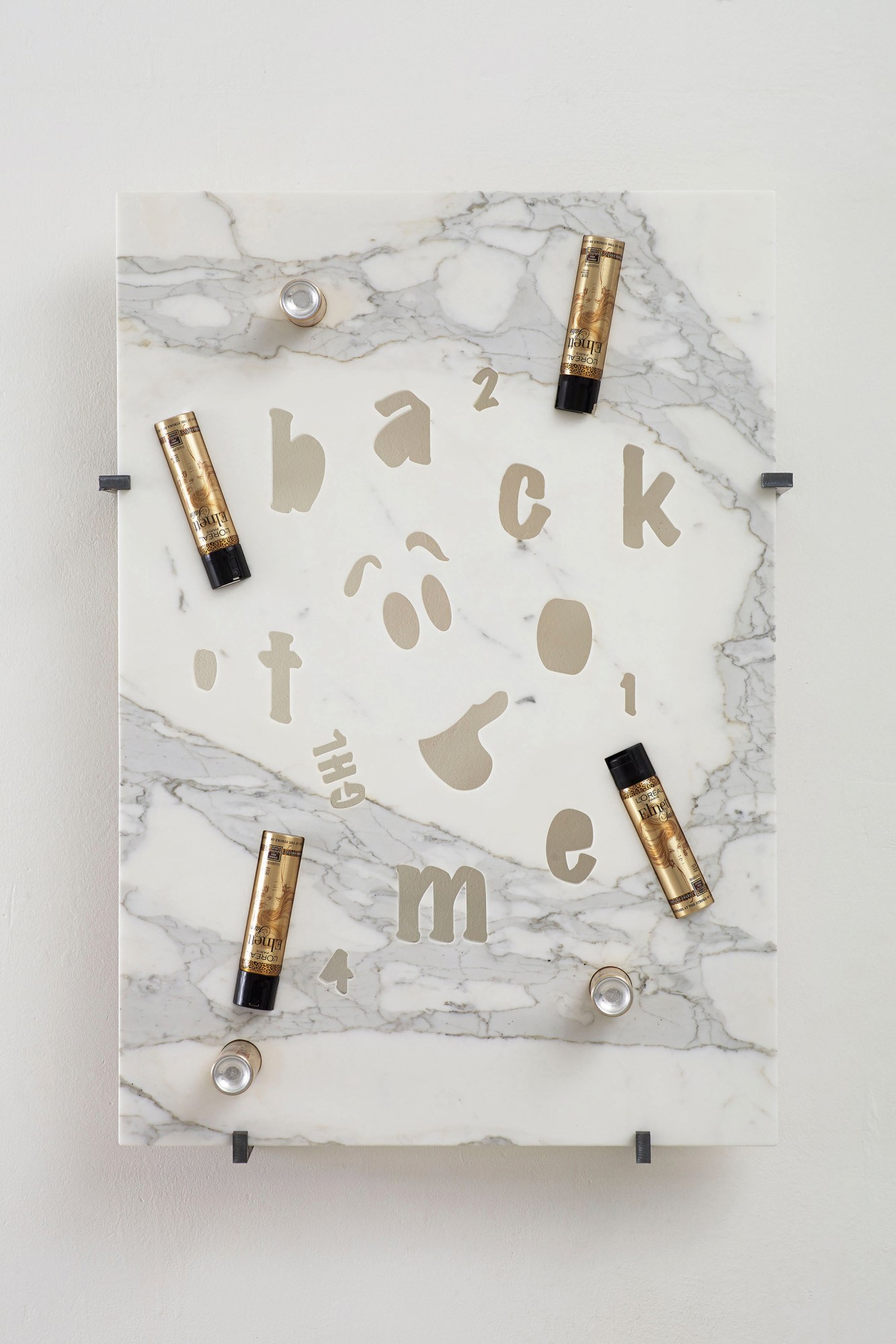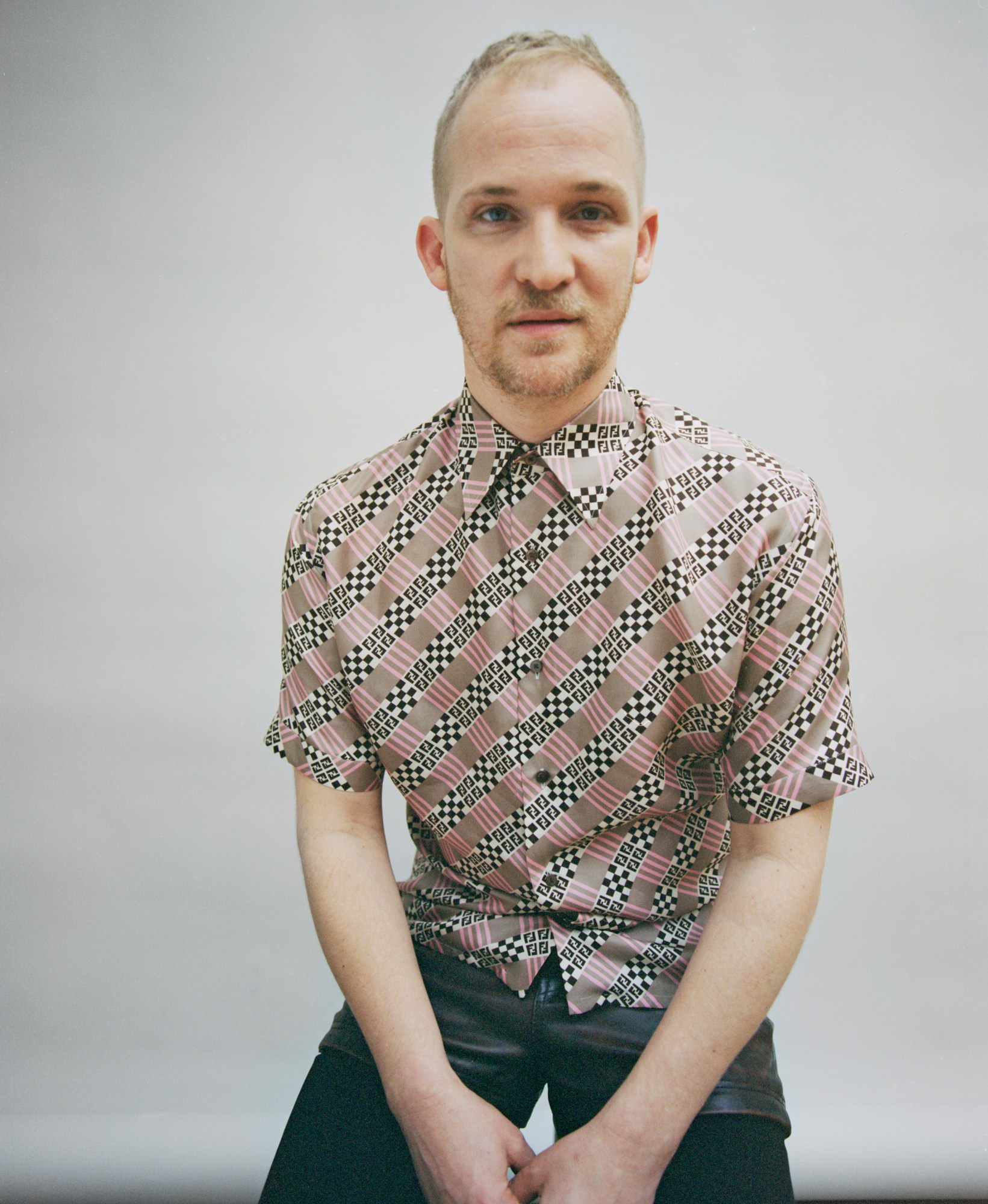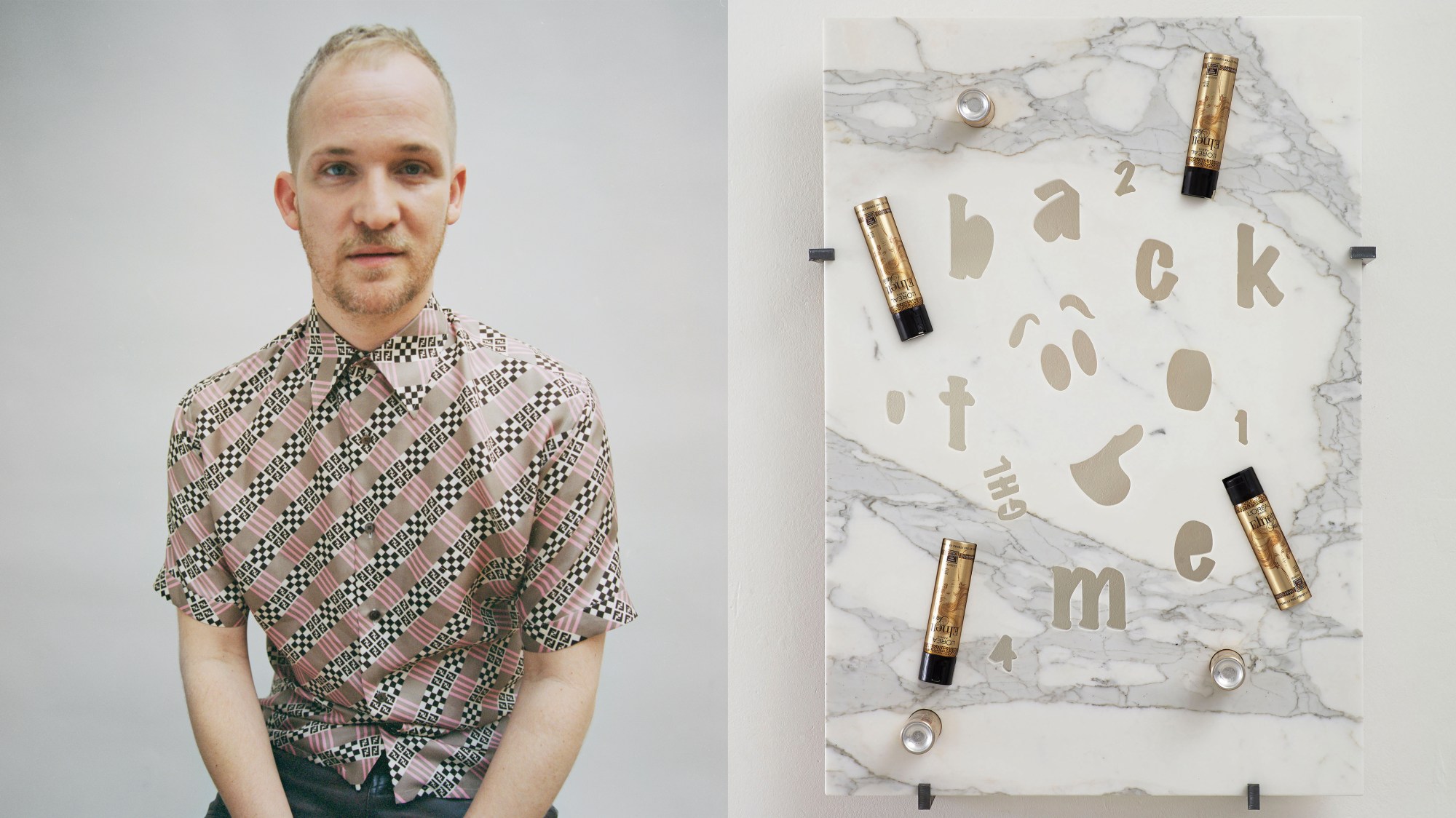This article originally appeared in The Radical Issue, no. 351, Spring 2018.
If art can feel like a friend, then George Henry Longly’s marble “poster” in London’s Hoi Polloi, is one of our bezzies. It’s funny, it’s challenging, it’s beautiful – much like its creator. The celebrated series of these posters shows an irreverent use of classic material, characterful fonts, schoolboy-style branded initials and a great choice of witty insertions (Regaine hair regrowth cans, YSL make-up pens and laughing gas canisters).
With GHL – as he’s known – there’s always a strong visual language and the creation of a very complete world, but just as you’re getting used to one aspect of his art, he shifts it, keeping you guessing, destabilising you. “I find it hard to be stuck with one visual language,” he says. “I don’t want to make the same work all the time. I think you can see a style of me somehow, but my approach changes. I think you’ve got to go with your gut instinct with everything you do. You have to trust yourself in order to expand yourself and move forward.”
This month, GHL takes a giant leap forward with the creation of his biggest artistic world in his first major institutional show at Paris’s Palais de Tokyo, the anti-museum museum that self-defines as a place that “invites us to bear witness to the audacities of our time and to live the experience of art in the making, in all its guises”. There’s probably no better fit for GHL’s work: a space that appreciates art as audacity.
“I think you’ve got to go with your gut instinct with everything you do. You have to trust yourself in order to expand yourself and move forward.”
Outside his studio on Dalston’s Ridley Road Market, the Halal butchers are shutting up shop and the last of the dancehall mixtapes are being sold. He’s been working from here for nearly a decade now (the after-parties there are the stuff of legend) and it’s heartening to see that the market is largely unaffected by gentrification, and that the nearby artists haven’t yet been turfed out for more luxury flats. GHL talks us through a crazily detailed 3D replica of the upcoming exhibition. He’s basically spent the past year living in a “hectic” SketchUp design.
The show is about “the extension of the self through technology” and he’s created a purposefully aggressive, manipulative, head fuck of a room. “I hope it’s going to be sublime too. God, don’t quote me on that,” he laughs, then says we can. Being about the self and technology, it inherently references internet culture but it’s also about “finding a space within that bombardment where things go quiet”. Some of that quiet can be found in the video of deep sea surveillance (he loves the “convivial enthusiasm” of the ocean floor online stream, Nautilus Live) and outer space probes – he’s obsessed with synthetic bodies that are sent into space to capture radiation and which lent his show its name, The Tissue Equivalent.

The exhibition came about when the Palais de Tokyo approached GHL to work with them on the collaboration they were planning with the Musée Guimet, France’s National Museum of Asian Art. They presented him with a collection of the exquisitely detailed Japanese armour that would have been worn by daimyos (feudal lords) and asked him to respond to it. Rather than exhaustively research the armour’s origins and be too literal in his response, he decided simply to “recognise the power they have as objects”. To do that, he’s taking them out of their glass cases and putting them on floating pedestals “so everything’s up in the air, everything is in question”.
He’s then set up structures around the daimyos to affect the way viewers move around: the lighting will change, the sound can be altered, barrels will be spinning, 101 bollards will cause blockages and a huge skewed floor print will shift everything off-centre. “It’ll be continually changing. Everything is in flux. It’s about how we have this experience of objects and space through the body.”
This is the way GHL likes to experience other people’s art too. “When I go to galleries, I’m definitely looking for a total experience. I recognise that not all mediums work in that way, but I’m desperate to feel something. I’m interested in sculpture and in work that you move around. I’m always looking to be touched by something. That’s how I understand things.” He loves to pace around the Chamberlain sculptures or the Dan Flavin pieces at New York’s Dia: Beacon “looking for an emotional response or a heightened sense of reality through that experience.”
“The creativity in this part of town is phenomenal. People push incredibly hard. There is real questioning and irreverence towards convention.”
This thirst for feeling is something that can be traced back to his early out-of-body party days back in the 90s, when Glastonbury, Bristol warehouse raves, Plymouth handbag house clubs and pills were truly transformative for him. “Glastonbury would come and suddenly there’d be a huge city just there. It’s pretty boring in Somerset, but going to free parties and going to clubs definitely reprogrammed me somehow. That’s why I’m interested in this heightened sense of reality. I was affected when I was 16 and it’s never really gone and I think many people can relate to that feeling of losing yourself. You’ve got to test the parameters, you’ve got to touch the sides.”
It’s also why GHL puts on his own parties, the soberly named Anal House Meltdown, with friends and fellow artists Prem Sahib and Eddie Peake. “We want that release. You’re dealing with an environment and you’re manipulating this environment. Maybe that can be related a little bit to making exhibitions and shows.” Cocktail D’Amore’s Omer has come over from Berlin to play, Peake has put on performances, there’s been a “bin bag darkroom” and Sahib’s cock ring flyer art is killer. The trio started off in London, but have since put nights on in New York, Rio, Venice and the far-off volcanic island of Stromboli. “It’s a fun thing to do. It brings people together,” he says. Attendees to the sweaty little AHMD parties are always likely to include GHL’s friends Jeffrey Hinton, Princess Julia, Nasir Mazhar, as well as his riotously fun boyfriend, the illustrator James Davison (one half of Sketch Sesh, who’re also featured in this issue).
All these characters, parties, ideas and art put to bed the idea that east London is in any way played out: there’s still a far greater concentration of talent here than anywhere else in the land. “It’s a big cliché but everyone mixes and it’s really interesting,” GHL says. “It’s always excited me. The creativity in this part of town is phenomenal. People push incredibly hard. There is real questioning and irreverence towards convention. That’s really important to me – to be around what really excites me.”

Credits
Photography Nadine Ijewere
Styling Nicco Torelli
Hair Hirokazu Endo using Bumble and bumble. Make-up Amy Conley at Stella Creative using CHANEL Rouge Coco Lip Blush and Serum Eye. Photography assistance James Gilbert. Styling assistance Pensira Kira Nakan. Production Roberta Arcidiacono.
